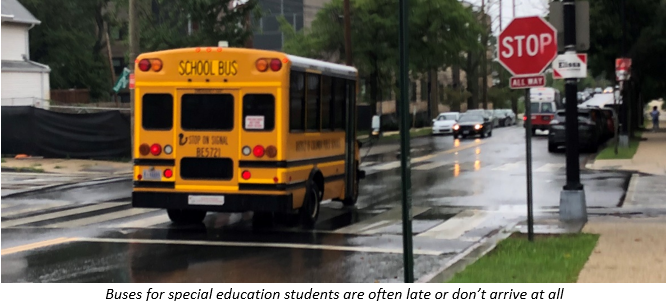This winter DC students will spend long mornings riding public transit and slogging through rain and snow on their way to school. How does the absence of a centralized school bus system affect educational outcomes in the District and what can we do to offset this?
The slow approach of winter brings to light an issue facing many District families. As a city, DC lacks a school bus system and instead relies on public transit, parents, and the students themselves to get students to and from school.
Unfortunately, when the weather gets bad public transportation suffers and this impact is felt by students. Long walks through rain and snow and long periods waiting at bus stops can increase tardiness and decrease performance for students struggling with their daily commute.
While the District provides buses for 3,000 special education students, the 95,000 other DC Public and Charter school students must find other ways to get to class. For most, this means walking or taking public transportation.
According to an Urban Institute report, 45% of DC students either walk to school or take public transit, with the average public transit commute for DC 9th graders being 30 minutes.
While special education students are provided with dedicated school buses, they can be unreliable, resulting in tardiness and missed days of school.
Why exactly do so many students face long commutes to school? It’s a combination of access and the DC lottery system that result in students attending schools located across the city.
Of all DC high school students, only 23% have a school located in their neighborhood. Even for those with a nearby school, only 26% of high school students attend their nearest school. Among elementary school students, this number drops to 13%.
This is because students are willing to travel farther to access higher performing schools. Unfortunately, as reported by Greater Greater Washington, black students are located on average farther from higher performing schools than their non-black peers.
This inequity is further complicated by whether a family has access to a car, as the average commuting time increases at least two-fold when comparing public transit to transportation by car.
Long commutes become particularly problematic during winter months. Any time students spend walking to school or waiting at the bus stop puts them at the mercy of the weather. According to CIS Site Coordinator Jason McCrady, “If the weather is bad they might not come to school, because they have to walk to the bus stop and wait in the rain or snow.” This is especially a problem for low-income students who may have difficulty affording adequate winter clothing.
Even during the warmer months, students risk experiencing harassment, witnessing drug use, and more. And all of this before 8am.
In an interview with WUSA9, Tysheka Duffy, School Counselor for Kramer Middle School explained how, “from the time they wake up in the morning to coming to school, on the way to school, they see negative things.”
With all of the experiences students have during their morning, it is no wonder that long or difficult commutes can impact academic performance. Students arrive at school tired, irritable, and less ready to focus on their academics. Longer commutes also prevent students from engaging in extra-curricular activities, due to time constraints.
While educators today are pushing hard to decrease tardiness and improve academic outcomes, it is important to recognize these environmental factors that must be addressed. If we want equal opportunity, we must provide for equal accessibility.
In the meantime, CIS site coordinators like Jason will work with students and parents to find ways to optimize their commute, from finding transportation alternatives to and obtaining weather appropriate clothing for frigid mornings. Hopefully a little support from a caring adult can make those early bus rides a bit more manageable.




